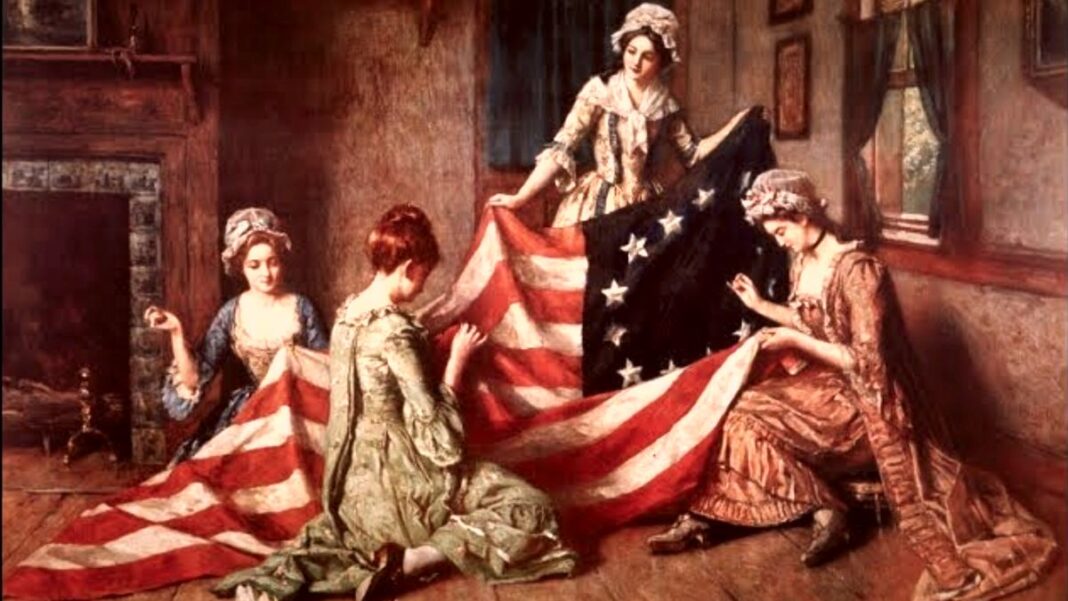The Betsy Ross flag, recognizable by many as the iconic flag used in the film The Patriot and featured in the painting Washington Crossing the Delaware, has recently come under attack. This flag, an emblem of the American War for Independence, has now been labeled as racist and a symbol of slavery.
The “Betsy Ross flag” became America’s official flag on June 14, 1777. In 1818 President James Monroe signed an act designating that the flag would have thirteen horizontal red and white stripes and a white star for each state in a blue field. Years later, President Harry S. Truman designated June 17 as our official Flag Day. The colors used in our flag each have deep meaning tied to the founding of our country—red stands for the blood sacrificed for our independence; white represents the loyalty that we feel toward our country; blue signifies the unity under which we fought.
Slavery had already existed for over 150 years before the American War for Independence. Because the institution contributed widely to the economic stability of the colonies, it was clear that slavery could not be abolished overnight. Many who owned slaves recognized that slavery was morally wrong. This included George Washington and Thomas Jefferson, who personally took steps to abolish slavery even though certain legalities hindered them from freeing their slaves as soon as they wished. However, these men (and many others) were well known for treating their slaves with kindness. An example of this can be found in Washington’s relationship with his slave companion, William Lee. Washington and William Lee (called “my fellow” by his master) were good friends. Before the war they often went hunting together; during the war, William Lee was never far from his master’s side. Lee was eventually emancipated by Washington. “Were it not . . . that I am principled against selling Negroes, as you would do cattle in the market,” Washington commented in 1794, “I would not in twelve months from this date be possessed of one as a slave.”
While some might argue that the Betsy Ross flag stands for racism, in truth it stands for unity. Before 1777, each colony had its own flag until it became apparent that the colonies should have one flag to stand, not only for their cause of freedom, but for unity. In fact, during the American War for Independence, African Americans helped the Continental Army to maintain a peaceful atmosphere because it showed the army that unity was essential to victory. General Washington allowed African Americans to enlist, giving the Continental Army the distinction of becoming the first integrated national institution in the United States. During the war, some states allowed slaves to earn their freedom in exchange for service in the militia. It is estimated that 5,000 African Americans served in the American War for Independence.
Following the war, when delegates gathered in Philadelphia in 1787 to frame the Constitution, they incorporated into the document that the slave trade must be prohibited by 1808. In 1825 James Madison wrote, “The magnitude of this evil [slavery] among us is so deeply felt, and so universally acknowledged; that no merit could be greater than that of devising a satisfactory remedy for it.”
So, the Betsy Ross flag does not symbolize racism or slavery—it stands for our freedom and how we obtained that freedom. Today’s Stars and Stripes is no different than the Betsy Ross flag; rather it is an updated version including all fifty states. Perhaps the blue on the flag, which stands for unity, is the most important symbol to remember today. We fought for our freedom together—black and white alike. Even if the Betsy Ross flag is someday outlawed, the spirit of it will live on in the hearts of true American patriots.
Bibliography:
- Allison, Andrew M., Jay A. Parry, and W. Cleon Skousen. The Real George Washington, 3rd ed. National Center for Constitutional Studies, 2010.
- Fischer, David Hackett. Washington’s Crossing. Oxford University Press, 2004.
- Mattern, David B., ed. James Madison’s “Advice to My Country.” University Press of Virginia, 1997.
- The Society of the Cincinnati. Why America is Free. The Mount Vernon Ladies’ Association, 1998.






